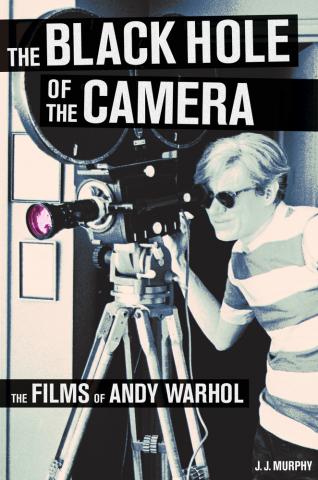
J.J. Murphy, author of “The Black Hole of the Camera: The Films of Andy Warhol” presents the films on Wednesday, October 9
EUGENE, Ore. -- (September 24, 2013) – J.J. Murphy, author of “The Black Hole of the Camera: The Films of Andy Warhol” will introduce and discuss two rarely screened Andy Warhol films in the season opener of Schnitzer Cinema on Wednesday, October 9. Starting at 7 p.m., the screening includes the 16 mm Warhol films “The Velvet Underground in Boston” and “Bufferin” as well as Murphy’s short film “Sky Blue Water Light Sign.” Cosponsored with the Cinema Pacific film festival, the screenings are free and include free popcorn and soda.
In the 33-minute film “Bufferin,” American poet, photographer, and archivist Gerard Malanga reads poems and diaries in which the well-known pain reliever replaces the names of actual participants. As a result, the viewer is forced to listen carefully to clues to decipher the names and context of Malanga’s gossipy revelations about various people, including the Pop artist. Made in 1966, “Bufferin” was the first film in which Warhol used the strobe cut extensively, giving the impression of a roughly edited splice whereas, in reality, all editing was done in-camera.
“The Velvet Underground in Boston,” which Warhol shot during a concert at the Boston Tea Party, features a variety of filmmaking techniques. This 33-minute film includes sudden in-and-out zooms, sweeping panning shots, and in-camera edits that create single-frame images and bursts of light like paparazzi flashbulbs going off. The film mirrors the experience at the Exploding Plastic Inevitable, a series of multimedia events organized by Warhol between 1966 and 1967, with its strobe lights, whip dancers, colorful slide shows, multiscreen projections, liberal use of amphetamines and overpowering sound of The Velvet Underground.
Warhol, one of the 20th century’s major visual artists, was also a prolific filmmaker who made hundreds of films. In his book, “The Black Hole of the Camera: The Films of Andy Warhol,” Murphy presents a comprehensive study of Warhol’s brilliant collaborations with writers, performers, other artists and filmmakers. The book further demonstrates how Warhol’s use of the camera transformed the events being filmed and how his own unique brand of psychodrama created dramatic tension within the works.
Murphy will also screen his 1972 short film, “Sky Blue Water Light Sign,” a 9-minute short film described by film critic Scott MacDonald as “one of the happiest, most uplifting short films I’ve ever seen.”
J.J. Murphy is a well-regarded critic and scholar of independent film, having published two books, “Me and You and Memento and Fargo: How Independent Screenplays Work” and “The Black Hole of the Camera: The Films of Andy Warhol” in 2007 and 2012, respectively. In the 1970s, he was best known as a creator of experimental films, including “Print Generation,” which won a major prize at the 5th International Experimental Film Competition in Knokke-Heist, Belgium in 1975. He is currently Professor of Film in the Department of Communication Arts at the University of Wisconsin-Madison., USA.
Upcoming programs in the Schnitzer Cinema series include “The March,” on Wednesday, November 13 and “A Few Notes on Our Food Problem,” on Wednesday, December 11. Both films are part of a campus wide tribute to University of Oregon alumnus and documentarian James Blue. All films will be screened in the Jordan Schnitzer Museum of Art Ford Lecture Hall and start at 7 p.m.
Curated by Cinema Pacific festival director Richard Herskowitz, Schnitzer Cinema is the JSMA's monthly showcase for adventurous cinema, featuring screenings and live presentations or Skype dialogues with special guests. Schnitzer Cinema is brought to you in partnership with Cinema Pacific and the Jordan Schnitzer Museum of Art.
About the Jordan Schnitzer Museum of Art
The University of Oregon's Jordan Schnitzer Museum of Art is a premier Pacific Northwest museum for exhibitions and collections of historic and contemporary art based in a major university setting. The mission of the museum is to enhance the University of Oregon’s academic mission and to further the appreciation and enjoyment of the visual arts for the general public. The JSMA features significant collections galleries devoted to art from China, Japan, Korea, America, Europe and elsewhere as well as changing special exhibition galleries. The JSMA is one of six museums in the state of Oregon—and the only university museum--accredited by the American Alliance of Museums.
The Jordan Schnitzer Museum of Art is located on the University of Oregon campus at 1430 Johnson Lane. Museum hours are 11 a.m. to 8 p.m. Wednesdays, and 11 a.m. to 5 p.m. Tuesdays and Thursdays through Sundays. Admission is $5 for adults and $3 for senior citizens. Free admission is given to ages 18 and under, JSMA members, college students with ID, and University of Oregon faculty, staff and students. For information, contact the JSMA, 541-346-3027.
About Cinema Pacific
Cinema Pacific is an annual film festival based at the University of Oregon in Eugene that is devoted to discovering and fostering the creativity of international films and new media from Pacific-bordering countries, including the U.S. Through onsite and online presentations, the festival connects stimulating artists and ideas with a diverse public, furthering our understanding of world cultures and contemporary issues.
About the University of Oregon
The University of Oregon is among the 108 institutions chosen from 4,633 U.S. universities for top-tier designation of "Very High Research Activity" in the 2010 Carnegie Classification of Institutions of Higher Education. The UO also is one of two Pacific Northwest members of the Association of American Universities.
Contact: Debbie Williamson Smith, 541-346-0942, debbiews@uoregon.edu
Links: Jordan Schnitzer Museum of Art, http://jsma.uoregon.edu
Cinema Pacific, http://cinemapacific.uoregon.edu/
- Log in to post comments






